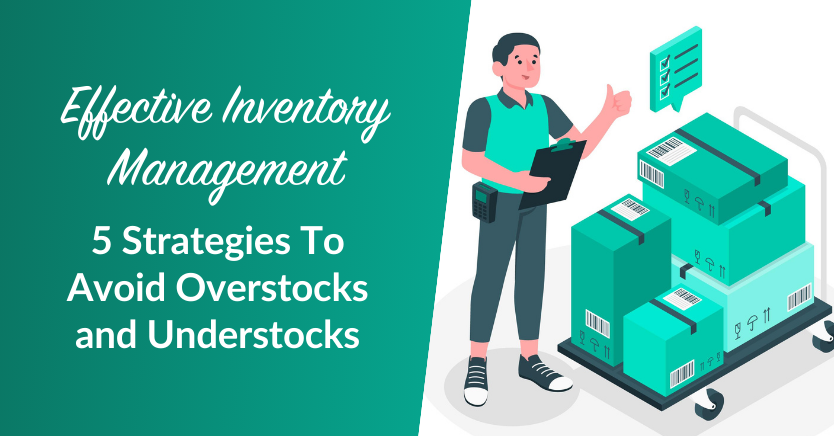Effective Inventory Management: 5 Strategies To Avoid Overstocks and Understocks


For wholesale businesses, the question of how much product to stock has been an age-old dilemma. Stock too few, and you risk missed sales opportunities; stock too many, and you’re burdened with excess storage costs and surplus inventory. This is exactly why effective inventory management is crucial.
Every year, businesses of all sizes leave money on the table due to poor inventory decisions. However, this doesn’t have to be the case for your business. In this guide, we’ll provide practical strategies to improve your inventory management and boost sales opportunities.
So let’s get started!
What Is Overstocking And Understocking?
Overstocking
Overstocking happens when wholesale businesses hold more inventory than they can sell within a given timeframe. Unfortunately, this has negative impacts on your business, including:
- Financial Loss: Excess inventory ties up valuable capital that could be invested elsewhere. This also limits your ability to respond to market opportunities or emergencies.
- Excessive Inventory Costs: Overstocking requires additional storage space, which comes with rent and maintenance expenses. These ongoing costs can eat into your profit margins.
- Product Markdowns: Products that stay on the shelves for too long may become outdated or go out of season, resulting in markdowns.
Understocking
On the other hand, understocking happens when a business doesn’t stock enough products to meet customer demand. Like overstocking, it also comes with negative consequences for your wholesale business, including:
- Missed Sales: Without adequate stock levels, you can’t fulfill customer orders, resulting in lost sales. This can also result in your customers turning to competitors with better product availability.
- Dissatisfied Customers: Consistently failing to fulfill orders due to understocking can lead to customer frustration. In turn, this destroys their trust and damages your business reputation.
- Higher Costs: Buying your inventory in bulk allows you to take advantage of discounts and deals from suppliers. Frequent reordering to compensate for understocking can result in higher overall costs for your business.
Effective Inventory Management: 5 Strategies To Avoid Overstocking And Understocking
Now that we’ve learned about the negative impacts of overstocking and understocking for your business, the importance of effective inventory management becomes crystal clear. In this section, we’ll explore key strategies to help you avoid these costly pitfalls.
1. Choose the right demand forecasting approach
The nature of your wholesale business can dictate the demand forecasting strategy that will work best for you. For example, wholesale businesses that offer the same type of products throughout the year may benefit from historical demand forecasting.
Here are some key strategies to consider and when they can be beneficial:
ABC Analysis
In this approach, products are categorized in A, B, and C based on their importance and sales volume. A items contribute more sales, requiring more detailed forecasting. This strategy benefits businesses with several product offerings with varying demand patterns.
Historical Demand Forecasting
This approach uses past sales data to predict future demand and can be effective for businesses with stable product offerings and consistent demand patterns. Take the pharmaceutical industry, for example. They often rely on historical demand forecasting due to the steady demand for essential medications year after year.
Just-in-Time (JIT) Inventory
This approach entails ordering inventory only when needed. They can benefit businesses with products with short shelf lives or rapidly changing market trends, like the fashion industry.
Safety Stock
Maintaining safety stock is crucial for businesses vulnerable to fluctuating demand or supplier delays. For instance, an agricultural supply wholesaler might keep safety stock of fertilizers and pesticides to meet demand spikes during planting seasons.
2. Leverage an inventory management system
Some businesses start tracking inventory manually using spreadsheets, but this can quickly become error-prone as the business grows. For modern wholesale businesses, it’s a must to use an inventory management system to make the process more efficient.

These systems provide a centralized platform for tracking and managing inventory levels, orders, and sales data. By doing so, they enhance real-time inventory visibility, allowing you to make informed decisions.
There are a lot of inventory management systems available, so it is just as important to asses what your business needs. Here are some questions to consider:
- What size is your business? The size of your operations will determine the complexity of the system you require.
- What sales channels do you have? If you sell through various channels, such as e-commerce, physical stores, and distribution centers, you’ll want a system to manage all of them.
- What are your growth projections? Ensure that your chosen system can scale alongside your business without significant disruptions.
3. Embrace automation at every stage
Automation is a game-changer for effective inventory management. Aside from using an inventory management system, embracing automation at every stage of your sales process is crucial to enhance efficiency.
Take using automated order forms, for instance. They help enhance efficiency by simplifying the ordering process, allowing wholesale customers to effortlessly browse your products, specify quantities, and submit orders online. As a result, you save time and reduce the potential for order errors.

This step also includes leveraging powerful lead capture and customer relationship management (CRM) tools. These systems can automate follow-up emails, reminders for reorders, and personalized communications to help you improve customer relationships.
4. Build strong relationships with your suppliers
While often underestimated in effective inventory management, building good relationships with your suppliers is just as crucial. These partnerships significantly impact your ability to maintain optimal inventory levels. With strong supplier relationships, you enjoy:
- Flexible Ordering: Building a good rapport with your suppliers allows for more flexibility in ordering, as they are more willing to accommodate changes in order quantities and schedules.
- Reliable Deliveries: Suppliers that value your partnership are more likely to prioritize your orders and provide timely deliveries, reducing the risk of understocking.
- Better Communication: Open lines of communication made possible by strong relationships make it easier to share demand forecasts and changes in product requirements.

Communication, transparency, and consistency are key to improving your supplier relationships. Make sure to openly communicate to discuss expectations and provide constructive feedback when necessary. Likewise, make sure to be consistent with your orders and payments.
5. Conduct inventory audits regularly
Conducting regular inventory audits is an important practice in effective inventory management. These audits involve thoroughly reviewing and assessing your inventory levels to ensure accuracy. They provide several benefits that contribute to effective inventory management.
For instance, they help you determine slow-moving items in your stock that occupy valuable storage space. By identifying these items, you can make informed decisions about handling them, whether through promotions, discounts, or discontinuation.
Moreover, they help you keep an accurate inventory record, aiding in demand forecasting. In turn, this reduces the risks of overstock and understock.
It’s important to establish a schedule that will work for your business, whether it’s quarterly, semi-annually, or yearly. During these audits, cross-verify your actual inventory with your records and document any discrepancies.
Conclusion
Avoiding the pitfalls of overstocking and understocking can help your wholesale business succeed in today’s competitive market. As such, it is important to ensure effective inventory management at each stage of the sales process. In this helpful guide, we’ve provided five key strategies to help you do that.
To recap, here are five key tips that can transform your inventory management:
- Choose the right approach
- Use an inventory management system
- Implement automation at each stage
- Build strong supplier relationships
- Schedule regular inventory audits
As you explore these strategies, consider incorporating automation solutions like Wholesale Order Form and Wholesale Lead Capture. These tools seamlessly integrate into your operations, creating streamlined ordering processes that reduce the risks of order errors and enhance overall efficiency.
Do you have questions about optimizing your inventory management? Feel free to comment down below!
The post Effective Inventory Management: 5 Strategies To Avoid Overstocks and Understocks appeared first on Wholesale Suite.











